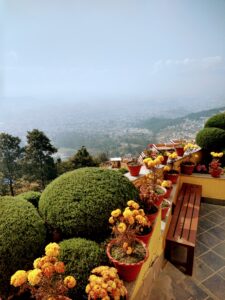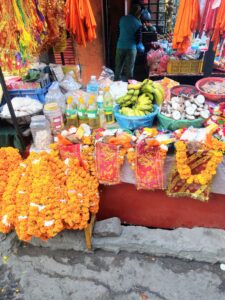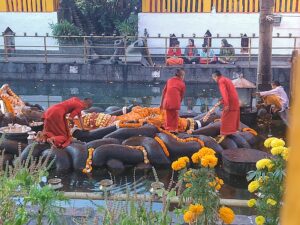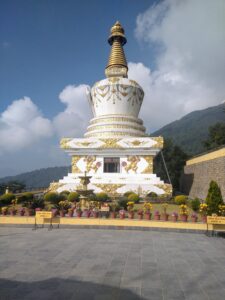Morning in Kathmandu
We rose before dawn. Roosters crowed and cows mooed as we walked in the brisk morning air through the green walled streets of Budhalinkantha. The Himalayan foothills partially enshrouded in fog offered glimpses of their enormous witness. Schoolchildren in blue and white uniforms emerged from behind the gates of the walled streets. Tea houses and nurseries were already doing business. Flowers, especially marigolds were everywhere and a bright red flower on a vine wound around the top of many of the gates of the homes. People with large carts of freshly harvested vegetables walked past us with purpose. Many street dogs were adorned with marigold garlands and bore remnants of tilaka (tikka) on their third eye, a red mark from sandalwood paste applied during a festival of prayer for dogs in Nepal called Kukar Tihar.
Jal Narayan Temple
We reached the main street that runs through Budhalinkantha where many motorbikes, public buses, small taxis and Tuk-tuks wove in and out of traffic. The smells of exhaust and the sounds of many small sharp horn beeps joined the sounds of merchants, more school children and many others walking with purpose. Steadily walking as the incline of the street increased, we approached the Jal Narayan Temple in Budhalinkantha, an open air temple from the seventh century that has as its central focus, a large reclining statue of Vishnu (the Preserver) on a giant snake in a pond. There were more people here at the open gate to the temple. Merchants and vendors were selling bananas, garlands of marigolds and more.
There was an air of excitement. Rojina and Robin led the way and knew where to go, and what to do including where to offer a few rupees. We approached the temple steps and an elderly woman put tikka on our foreheads, offering prayers and blessings. We visited several smaller shrines to Saraswati and Ganesh walking clockwise around these ornate stone shrines and ringing bells. The energy level was high and I experienced it as a festive and joyful devotion. I could feel my feet on the ground, on the ancient stone, the crisp air, the smell of incense, the bright blue sky, bells ringing and my heart opened so vast and wide. Even feeling grounded and connected, it felt otherworldly and magical. My husband John and I were the only white people present and people, if they did engage, did so with smiles and “Namaste”.
As we stood above the sleeping Vishnu we heard the sound of singing and bells. To our right, a line of Brahmin boys with red robes and the sides of their head shaved proceeded into the area of the reclining Vishnu and began reverently washing the statue and adorning it with flowers. The energy of the crowd, who now all gathered around the sight, spoke to this being a special ritual. The boys were deliberate and surefooted on the statue, every movement a gesture toward the sacredness of washing and adorning Vishnu. Above us, monkeys chattered in the trees and more and more people began to enter the temple.
Jamchen Vijaya Stupa
As the ritual came to an end, we walked out of the temple, which by this time had a long line of people waiting to enter. After breakfast where a family of monkeys climbed up and down the wall of the building outside our window, we caught a cab to take us up a steep mountain road to a newer temple, the Jamchen Vijaya Stupa.
The cab ride was a bit harrowing on this almost vertical road with no guardrails and we soon left the noise and clamor below at a pace that was a bit disarming but the driver seemed confident.
We finally reached the top or what appeared to be the top of the ridge (it wasn’t) to this enormous stupa which overlooked Kathmandu Valley. The sky, a brilliant blue and the stupa, white and gold seemed to pierce the heavens. In contrast to the crowds below, there were a couple of other folx. The sacred here had an energy of vastness and awe. Eagles soared at the same height where we stood. Below the stupa was a building further down on the hillside. The sonorous chanting of the monks there rose up to where we stood in front of the stupa. We stood transfixed by the sound which seemed to extend up, out and all around. Rojina told us that this chant was a prayer for peace in the world.
Peace & Devotion
This world. This beautiful, terrible messed up world. This world where war continues to rage in the Ukraine, the intensity of the bombing in Gaza and the increasing humanitarian crisis there occupies the heart and mind space of many, as well as violence and displacement of persons in the Sudan and other parts of the world.
The monks chant for this world.
Standing here in front of this enormous stupa in a land on the other side of the world far away from what is known and familiar to me, all of humanity felt present, real and close. In this vast space, the chants and the awareness of this devotion, attention and intentions toward peace, supported this experience of being full of love and devotion yet empty of urgency or the need to figure anything out.
The liminal space of the sacred exists outside of linear time, time that is not measured by minutes but experienced through presence. I felt myself as both new and ancient. An infant and an elder.
The world is not well but the soul can find peace, even in conflict, not in entrenched views but as spaciousness that is also grounded and recognizes devotion cannot be explained. It is a sacred mystery that meets the longing in the soul with not certainty, but more questions that expand and open the heart.








